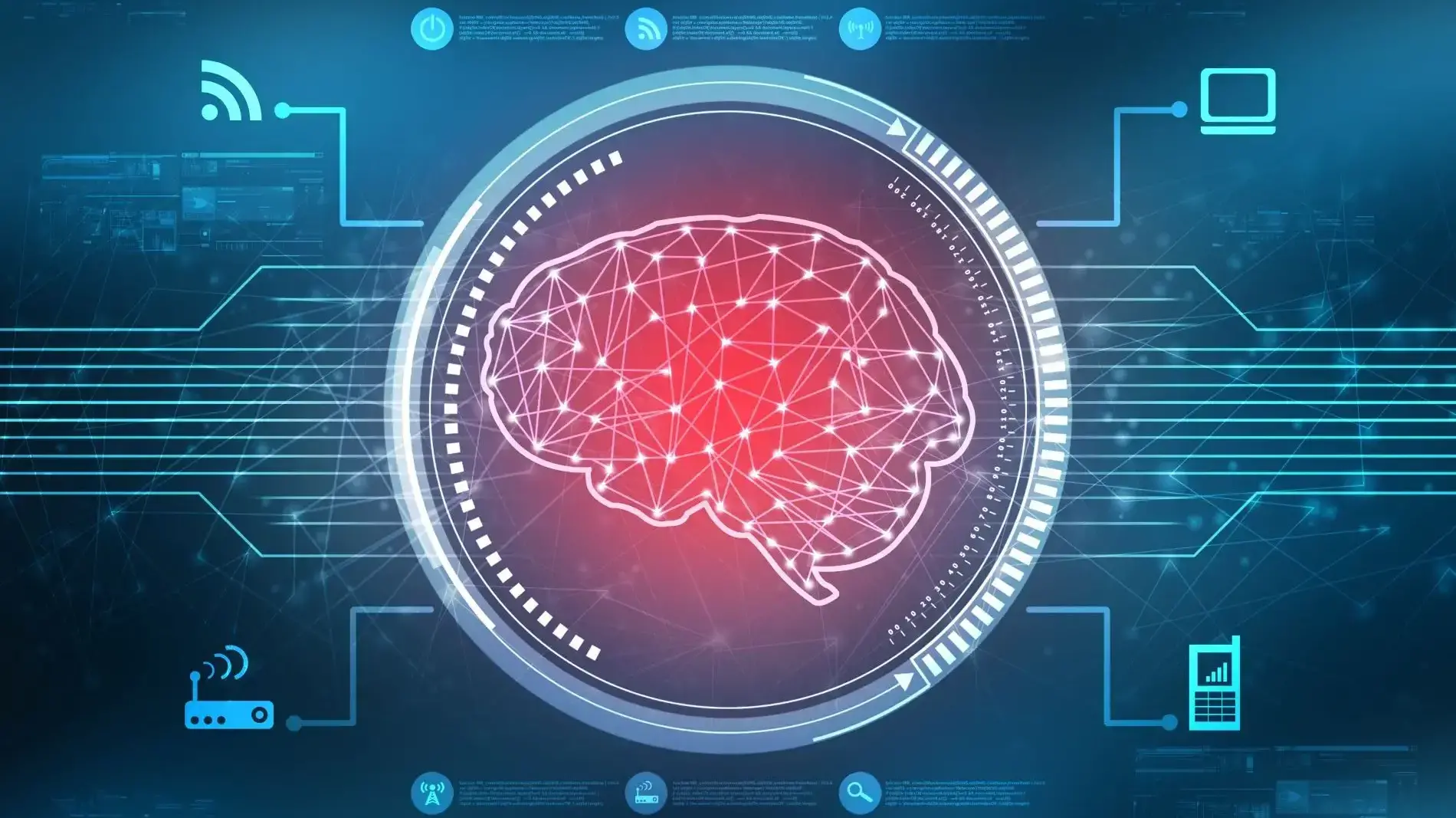The basic idea of neuromorphic computing is to create a chip that emulates the brain's functionality. By rethinking computing, scientists are applying the latest understanding of neuroscience and intersecting it with computer science.
This has brought about advancements in various fields like cognitive science, motor neuroprosthetics, etc.
Computers have been built to mimic the brain for decades. For instance, Frank Rosenblatt developed the Perceptron algorithm in 1958, a type of artificial neural network designed for simple pattern recognition tasks. The Perceptron was inspired by how the brain's neurons process information.
Neuromorphic computing systems are designed to replicate the structure and functionality of the brain to perform various tasks effectively.
In this article, we'll explain what neuromorphic computing is and why it is gaining traction across different applications.
What is Neuromorphic Computing?
Neuromorphic computing was inspired by a biological phenomenon called Synaptic Plasticity which is our brain's ability to change and adapt in response to new information.
The Neuron cells in the brain are known as the messengers. They are connected through synapses which are the junction points that link the neurons together, through which impulses and chemical signals are transmitted.
Neurons communicate with each other using electrical impulses called spikes. Spikes and synapses are essential in how the nervous system responds to mental activities.
When computing large data, traditional computers require large memory, this means the more the computation, the more memory capacity is required. Unlike the brain whose memory is created through new and strengthened connection between neurons by a process called synaptic plasticity.
The process of learning a new skill for instance can strengthen certain synapses and build long term memory in the brain. This is the one of the key reasons why the brain is a model for creating neurocomputing devices, its ability to adapt to changes, amongst many other reasons which we’ll see as the article progresses.
First, let us break Neuromorphic Computing into two parts to understand the concept separately before defining them as a whole.
Neuromorphic is defined as any large-scale system of integrated circuits that mimics neuro-biological architectures present in the nervous system; in other words, a system designed using the structure and function of the human brain.
Neuro: refers to the neurons or the nervous system.
Morphic: refers to a form or structure.
Computing is defined as the process of using computers to perform various tasks or solve problems using algorithms and software.
The conventional CPU is designed differently from the way the brain works. Ninety-nine percent of conventional chips are synchronous in design, making them rigid and sequential.
Neuromorphic computing, however, represents the latest in neuroscience and computer architecture. Its asynchronous nature is a completely different approach from the norm.
Neuromorphic computing is inspired completely by the brain's functions. It involves designing and engineering computers to mimic the neural architecture and functionality of the human brain. With neuromorphic chips, scientists are creating a vast network of neurons without any prescribed order, resulting in much more flexible functionality.
The brain is typically more efficient in terms of energy consumption, parallel processing, and so forth. Unlike traditional computers, it can perform several tasks without expending too much energy, where more data requires more computing power.
Neuromorphic computing seeks to leverage the brain's architecture to create more powerful and efficient systems for different tasks like decision-making, adaptive learning, pattern recognition, and more.
Principles of Neuromorphic Computing
As a subset of artificial intelligence, neuromorphic computing utilises several principles, which are:
Parallel Processing: The parallel structure of the human brain is such that numerous neurons and synapses operate simultaneously. Neuromorphic systems mimic this by enabling neurons and synapses to function autonomously and side by side with other neurons and synapses.
This improves the efficiency of neuromorphic systems such that single processing units are not overworked and can handle complex computations efficiently.
Event-Driven Computation: Neuromorphic computing systems follow an event-driven approach to computation. This means that computation occurs only when there’s a need for it and when there’s available data.
The systems are designed so that neurons and synapses are engaged in response to spikes or changes in data events, similar to how neurons in the human brain operate only when there's a signal to transmit.
Stochasticity: Neuromorphic systems have a Stochastic nature, which means they can assign probabilities to each neuron instead of deterministic values.
In simpler terms, this nature or behaviour causes the system to act randomly, mimicking the variability in biological neural networks. This allows the system to explore a different range of possible solutions during an operation rather than producing the same solution each time.
Scalability: Neuromorphic systems are designed to scale, meaning that they can become larger, handling more neurons and synapses without negatively impacting the system's overall structure and performance.
Plasticity: The notion of plasticity in neuromorphic computing systems involves the ability to learn in real time. These systems can continuously adapt based on inputs or experiences, allowing them to improve their problem-solving capabilities.
Benefits and Limitations of Neuromorphic Computing
Benefits
Limitations
Benefits of Neuromorphic Computing
Neuromorphic computing is highly attractive, with neural networks modelled after the human brain. It can be used in advancing our understanding of human cognition, among other benefits, which include:
Energy Efficient: Neuromorphic computing is energy efficient, meaning that neuromorphic systems process and store data when it's needed, similar to how the human brain works. This event-driven approach allows the system to perform tasks using limited energy.
Faster Computing Power: Neuromorphic systems are designed to mimic real neurons by processing events only when necessary. This results in faster computation, requiring less energy when performing tasks. This approach enhances efficiency and can outperform traditional computing methods depending on the application.
Ability to Learn Fast: Neuromorphic systems are designed to learn and adapt to changes just like humans' brains. This capability is useful in applications that require real-time or continuous learning, including prompt decision-making and feedback.
Effective Pattern Recognition: Neuromorphic systems are great at recognizing patterns using (SNNs), which detect and respond to patterns in data using the timing and frequency of spikes. This parallel processing approach mimics how the human brain processes patterns.
Limitations of Neuromorphic Computing
There are several challenges and limitations in Neuromorphic computing. Some of the most prominent disadvantages include:
Steep Learning Curve: Neuromorphic computing combines elements from biology, computer science, mathematics, electronic engineering, physics and neuroscience which makes it a very vast and complex discipline.
Lack of Standardisation: Neuromorphic computing is a new field, which means that many companies are conducting their research and developing their own hardware and software solutions.
This has resulted in a variety of architecture with different design principles, components, and methods for mimicking neural activities.
Due to these differences, it becomes hard for systems to collaborate and for researchers to compare results across various platforms.
Complex Architecture: Neuromorphic computing systems can be complex to develop because the architecture of neuromorphic systems aims to mimic the human brain structure and functionalities of neurons, synapses and their connection.
Minimal Tools: Neuromorphic computing is still under development, therefore, there are limited hardware and software tools available for developing neuromorphic systems.
Use Cases of Neuromorphic Computing
Here are a few use cases of Neuromorphic Computing include;
Cybersecurity: Neuromorphic systems can help detect unusual patterns in network traffic that may signify cyber breaches. These systems can also predict potential threats based on historical data.
Robotics: Neuromorphic computing can enhance real-time learning and decision-making skills in robots. Also, it can be used for tasks like object recognition, obstacle avoidance, and more
Pattern Recognition: Neuromorphic computing uses its parallel processing capabilities in machine learning applications, including pattern recognition for natural language and speech, including analysing and processing images such as MRI scans of the brain.
Autonomous Vehicles: Neuromorphic computing mimics the brain's ability to interpret and utilise sensory information quickly, enabling it to process data from different sensors in real-time. This capability allows autonomous vehicle systems to make quick decisions and respond effectively to dynamic environments.
Healthcare: In the medical field, neuromorphic computing can be used for medical imaging in analysing complex medical images such as MRI and CT scans.
Neuromorphic systems can also be used in prosthetic devices; they enable intuitive control of prosthetic limbs.
Internet of Things: Neuromorphic systems can be used to automate appliances in a smart home by processing data from sensors like light temperature, motion, etc.
Summary
Neuromorphic computing is inspired by the brain’s ability to process information, solve problems and learn in real-time with minimal energy.
Neuromorphic computing is still in its earliest stages; however, its application in recent times can be seen in the development of Intel's Loihi, which is one of the world's largest neuromorphic systems, designed to support research in brain-related artificial intelligence.
It tackles the challenges related to the sustainability and efficiency of modern-day computing, such as high computing costs and high-power consumption associated with processors.
The Intel Loihi’s chip will be deployed in a wide range of real-world applications like autonomous vehicles and smart factories, which leverage IoT, AI, cloud computing and robotics to enhance manufacturing processes.
In summary, neuromorphic computing allows the development of systems that mimic the architecture and functionality of the human brain, enhancing various fields like robotics, IoT, artificial intelligence, etc.
Frequently Asked Questions
How do people use cloud computing?
Cloud storage allows you to access data from anywhere at any time, as long as you have an internet connection, freeing you from being restricted to a specific location or device.
Is cloud computing good for small businesses?
Cloud computing lets businesses store and access data and applications online instead of on physical servers, offering cost savings, flexibility, scalability, and security.
How does edge computing affect energy consumption and sustainability?
Edge computing can enhance energy efficiency by reducing the need to transmit large volumes of data over long distances. This has a positive impact on energy consumption and sustainability, especially in applications like smart grids and precision agriculture.
Can cloud computing be customized for industry-specific needs?
Yes, cloud computing can be tailored for specific industries, from healthcare, and data security to HR systems, thanks to its adaptable and scalable nature.

Jessica Agorye is a developer based in Lagos, Nigeria. A witty creative with a love for life, she is dedicated to sharing insights and inspiring others through her writing. With over 5 years of writing experience, she believes that content is king.
View all posts by Jessica Agorye




















